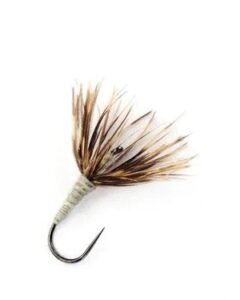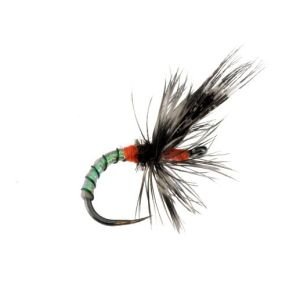 In Western fly fishing, an angler’s fly box is a treasure trove of options: dry flies, nymphs, midges, streamers, terrestrials with literally thousands of patterns falling within these categories. On top of that are the other thousands of patterns that aren’t “official” fly patterns but instead are individual creations of personal artistry and expression. When you really take a moment to reflect, it’s mind-blowing and a bit overwhelming, particularly to the beginner fly angler.
In Western fly fishing, an angler’s fly box is a treasure trove of options: dry flies, nymphs, midges, streamers, terrestrials with literally thousands of patterns falling within these categories. On top of that are the other thousands of patterns that aren’t “official” fly patterns but instead are individual creations of personal artistry and expression. When you really take a moment to reflect, it’s mind-blowing and a bit overwhelming, particularly to the beginner fly angler.
Over the last decade—yes tenkara has now been in the US for over a decade— “tenkara flies” have been added to this mix. However, there is still a lot of mystery surrounding them and whether they are the only pattern you can use on a tenkara rod. Let’s look at a few of these assumptions and finally get the real scoop.
A little history:
First things first. Tenkara flies do not consist of a single pattern. In fact, they can be very diverse. In Japan, where the method of tenkara fishing began, fly patterns were more consistent with regions. Local fishermen used what material was available to them in that area, and if the pattern worked, it was used and re-used. Period. Simplicity is valued in Japanese culture. Why change or complicate something that works? Thus, over time, the pattern became popular due to its effectiveness and eventually became associated with that region. But individual tenkara fishermen tied their own variations and patterns and had their own favorite, just as we do today.
Nowadays in the US, when people mention tenkara flies, those of us familiar with tenkara most often think of a Sakasa Kebari, or a reverse hackle, simple fly—silk or Uni thread wrapped around a curved shank hook with simple hackled tied forward. Interestingly, the Sakasa Kebari was not the most common patterned used by Japanese tenkara anglers. So why in America do we think of it as the tenkara pattern? Well, the Sakasa Kebari was novel, and different from anything we were using in the States when the fixed-line method of tenkara fishing was introduced here back in roughly 2009, so it stuck.

Why hackle forward?
There is no documented explanation of why a reverse hackle was used with tenkara rods in the first place, but there are a number of speculated reasons:
- Reverse hackle flies are easier to tie by hand—meaning without the use of a vise.
- Reverse hackle flies move more realistically in fast currents since the hackle doesn’t lay flat along the hook shank and creates some resistance in the water.
- Reverse hackle flies because of this resistance, allows the tenkara angler to keep a tighter line by removing slack resulting in an improved presentation and hook set.
Whatever the reason for the reverse hackle, we will never really know, but keep in mind that the origin of tenkara fishing was in the high mountain streams of Japan. The water moved fast, and the insect life was sparse. Fish were opportunist feeders. Dries or insects on top water were unrealists, certainly uncommon. Subsurface, wet fly action was where lunch could be found and in the scanty mountainous streams, the fish weren’t picky. There was no reason to “match the hatch”. Simple, vague patterns worked.
Do you have to use tenkara flies on a tenkara rod?
No. No, no, no. In fact, I use reverse hackle flies very rarely. My most common go-to set up is a dry dropper, but you can tie on whatever your heart desires—dries, nymphs, streamers, double droppers, dry droppers. Whatever you enjoy fishing, and whatever you think will catch fish can be used on a tenkara rod. We love our fly boxes packed with all those wonderful patterns. There is no reason to think you need to give them up to fish tenkara.
Can you use a tenkara fly on regular fly rod and reel?
Yes. Of course! Tenkara flies are essentially wet flies, so you can fish them similarly. The advantage of a tenkara rod is that, when fished traditionally, the line is kept off the surface of the water, which translates into an undisturbed, pristine drift and a very natural presentation. Tenkara rods also have super fine tip sections that are flexible and can be manipulated with the slightest most delicate movements of your finger or hand. These slight movements can bring your fly to life and make it a more realistic imitation of a drowning or morphing insect. And we all know that sometimes just adding a little action to your fly can make all the difference in your catch rate. A regular fly rod and do all of this. It’s just a bit easier to create that discrete action using a tenkara rod.

Streamers-Can you use streamer patterns on a tenkara rod?
Great question, easy answer, but I admit, I’m kind of cheating here. You can’t truly strip anything on a tenkara rod because you can’t… well… strip. The line is attached to the tip of a tenkara rod. With no guides and no line running down the length of the rod, stripping is impossible. However, you can jig on a tenkara rod, and that’s exactly what you do when streamer fishing on a fixed line. Make your cast. Lay your rod over to one side. Then begin to jig your streamer through the water as you draw your arm and the rod back and to the side. Admittedly, your “stripping area” will be smaller when on a tenkara rod, but the motion you can create and the control you have is exquisite and very life-like. You will get hits. I might even go so far as to say that setting the hook while streamer fishing on tenkara is slightly easier than on a rod and reel. So, fear not if you have a love of streamers. You can “strip” those lovely patterns on a tenkara rod.
Is tenkara effective for nymphing?
Oh my—tenkara was born to nymph! And the best part is you can get an amazing drift without all that high sticking and shoulder burning that is often accompanied with nymphing on a “Western” (aka rod and reel) set up. The traditional idea behind tenkara is that you have a long rod and a short line. The long rod provides that reach and makes keeping line off the surface of the water, easy. You can accomplish all this without holding your arm and rod up high and without aggravating your shoulder. The short line makes casting easy and landings even easier, and the short line does a few additional things: 1) it keeps the water undisturbed and spook-free, 2) it eliminates the need for mending and permits a natural unencumbered drift, and 3) it eliminates slack and keeps your line tight for improved hook sets. All beautiful when nymphing.
One additional benefit of nymphing with a tenkara rod is its sensitivity. Ultralight, often weighing less than 2.5oz, tenkara rods become extensions of your own arm and hand. High quality rods made from IM-12 carbon fiber are super sensitive yet strong. You can feel the smallest hit, the most delicate taste, the daintiest take by a fish, so much so that you can often rid yourself of an indicator and nymph naked. Well— with clothing— but without an indicator. So, tie on those nymph patterns to your tenkara rod and get ready for some real, reel-less action.

Closing thoughts on tenkara flies: No Right or Wrong
I’m here to tell you that tenkara fishing is much more versatile than you probably thought. Sure, experiment with a reverse hackle Sakasa Kebari fly. Play with it. Fish it. But hold onto those packed fly boxes filled with a plethora of patterns and use them all. Tie on whatever you want to your tenkara rod, and fish with what you like and what works for you. The “One Fly” theory around tenkara is a misnomer for sure. The truth around it lies with the reality that original tenkara fishermen in Japan didn’t have access to all the wonderful hackle, material, and hooks that we anglers have at our disposal today. They lived in small, often isolated villages and localized nature was their fly store. They created flies from things they found and collected. When they created a pattern that worked, and the materials were readily available, they continued to make and fish that pattern. If it didn’t work, they changed it up a bit. No great mystery, just a consequence of limited resources paired with the appreciation of simple effectiveness.




GREAT article !
Thank you.
Glad you enjoyed it!